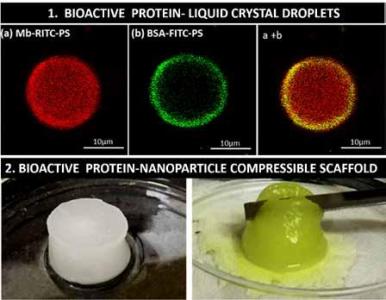
Design and development of muti-functional, hierarchically structured, and highly ordered materials is the key to the advancement in the field of materials nanochemistry, and bionanotechnology. These fields are likely to play an important role in driving markets, and economies in the developing countries by fulfilling their high demand towards the improvement in health, and energy sector. Specifically, the formation of biodegradable materials with novel properties, multiple functions, improved efficiency, and higher sensitivity can cater to the demand of health and diagnostics industry.
In this context, biomaterials fabricated using proteins / enzymes are the focus of much attention since these provide highly advanced functions, and properties which can be used for variety of applications in bioelectronics, bio-sensing, drug delivery, bio-catalysis and bio-nanocomposites. However, the road to the realisation of such a class of biomaterial involves combining/ incorporation of proteins / enzymes with other type of functionalities in the form of polymers (synthetic, and natural), surfactant, nanoparticles, liquid crystals, etc. In most cases this leads to denaturation, or unfolding of the protein / enzymes, and ultimately lost of their structure, and function. Clearly, a combination of both structure and function can provide high performance biomaterials in the form of films, hydrogels, nanoparticles, and fibres for use in various applications. However, at present there is a dearth of strategies for preparing protein-based biomaterials with retained structure and function at reasonable cost.
In our lab, we combine efforts with the help of bio-conjugation techniques to stabilise proteins / enzymes via surface re-engineering. This involves developing new methodologies to covalently, or electrostatically coupling polymer surfactant molecules to the acidic or basic amino acid residues at the protein surface, resulting in the formation of hybrid bio-conjugates. These bio-conjugates can thus be used as make new class of materials as standalone, or after integrating with structurally and functionally compatible components such as biomolecules, polymers, liquid crystals, colloidal particles, and small molecules. Overall, we envisage in developing and contributing significantly to advancing a new area of biomaterials engineering at the interface with soft matter chemistry which will directly, or indirectly help in solving scientific challenges, and problems in various industries involved in pharmaceutical, detergency, cosmetics, paints, health, and diagnostics.
Prof. Kamendra P Sharma
